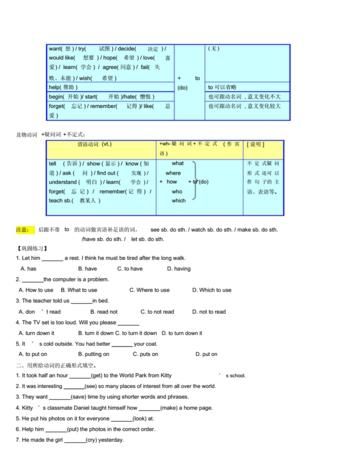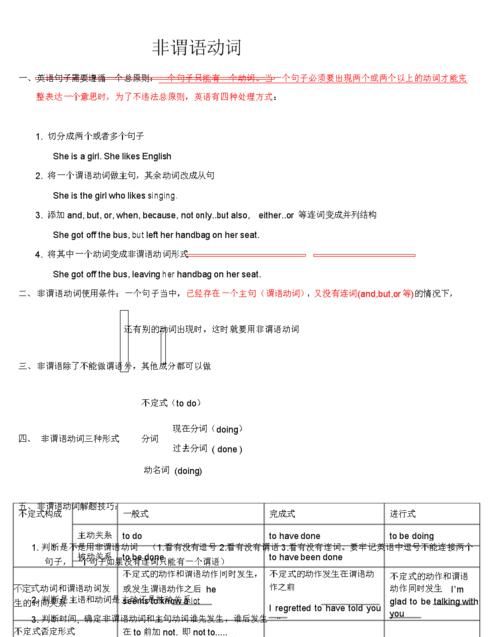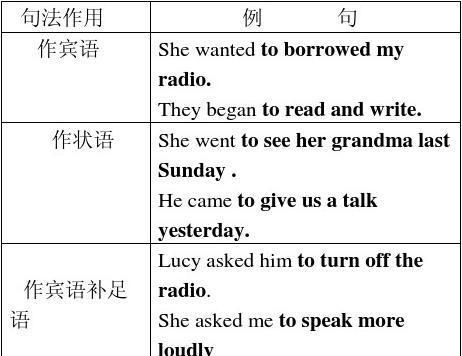本文目录
初中英语动词不定式和动名词归纳
动词不定式
不定式可在句中作主语、宾语、表语、定语、状语、补足语,但不能作谓语,可有自己的逻辑主语,即for/of sb to do。
1.不定式作主语
To do that sort of thing is foolish.
It would be better fou you to go there.
(it作形式主语代替后面的不定式)it be adj/n for sb to do sth
注意:不定式作主语表示某次特定的行动;动名词作主语表示经常性、习惯性的动作。
Walking after supper is helpful.
To walk in the street this evening will be nice.
2.不定式作表语
To see is to believe.
All you have to do is (to)finish the job quickly.
(当表语用来解释主语中do的具体内容时,表语中的不定式常常省略to)
3.不定式作宾语
He promosed not to tell anybody about it.
(不定式的否定形式为not to do)
He didn’t go to the party last night,but he intended to.
(不定式后的动词可承前省略,但to不省略)
I think it important for you to recite some English articles.
(如果不定式较长,可用it作形式宾语)
提示:以下动词只能跟不定式作宾语:afford agree ask attempt decide demand expect fail help hope manage offer plan prepare pretend promise refuse seem wish.
4.不定式作定语
There are many TV sets to choose from.
(1)当不定式之后有介词与其修饰的名词有介宾盥洗室,介词不能省略。
The room is large to live in.
The river is large to swim in.
(2)当名词前有序数词、最高级或next,only等修饰时,其后用不定式修饰。
Betty was the first(girl)to come.
He’s the only person to know the truth.
The easisest way to learn English is staying at an English family.
She has a wish to travel around the world.
5.不定式作状语
He spoke loudly(so as/in order)to be heard.(目的状语)
I’m to tired to walk any further this afternoon.(结果状语)
提示:不定式作结果状语长用于如下结构
so+adj/adv+as to do如此......以至于
such+adj+n+as to do如此......以至于
adj/adv+enough+to do足够......
too+adv/adj+to do太......以致不能
They jumped with joy to hear the news.(原因状语)
He raised his hand as if to take off his hat.(方式状语)
I’m very glad to see you again.
(不定式作修饰表语形容词的状语)
6.不定式作宾语补足语
(1)动词+宾语+带to的不定式。具有这种用法的动词有:advise allow ask beg cause chellenge drive encourage expect forbid force hire intend invite order permit persuade remind require teach remind tell want warn等。
She asked me to stay here.
(2)表示见解、看法的动词+宾语+带to的不定式(不定式常用to be或to have done形式)。具有这种结构的动词有:believe consider declare discover feel(认为) find imagine judge suppose think understand等。
I consider him to have done wrong.
(3)感官动词+宾语+不带to的不定式(被动式中必须带to,)。具有这种用法的动词有:see notice watch lookat observe hear listento feel等。
I heard the clock tick.The boy was seen to run down the street.
(4)使役动词+宾语+不带to的不定式(被动式中必须带to,但have一般不用于被动式)。具有这种用法的动词有:make have let等。
Shall I have him come here ?
They shouldn’t be made to do such heavy work.
(5)动词短语+宾语+带to的不定式。具有这种用法的词组有:arrange for ask for call on count on long for depend on rely on wait for等。
I’m waiting for you to reply.
高考真题
1.I like getting up very early in summer.The morning air is so good______.
A.to be breathed B.to breathe C.breathing D.being breathed
be+adj+to do不定式用主动形式。The house is comfortable to live in.
2.The director had her assistant______some hot dogs for the meeting.
A.picked up B.picks up C.pick up D.picking up
have sb do sth让某人做某事
3.I feel greatly honoured______into their society.
A.to welcome B.welcoming C.to be welcomed D.welcomed
考察非谓语动词。从句是看,这里用不定式作状语,用主系表+to do sth,这里用不定式的被动语态表示受到欢迎。
4.Due to the heavy rain and flooding,ten million people have been forced______their homes.
A.leaving B.to leave C.to be left D.being left
此处考察be forced to do sth固定结构。在force sb to do sth这一结构中,不定式作动词force的宾语补足语。
课后训练
1.I don’t want______like I’m speaking ill of anybody,but the manager’s plan is unfair.
A.to sound B.to be sounded C.sounding D.to have sounded
2.All these gifts must be mailed immediately______in time for Chrismas.
A.in order to have received B.in order to receive
C.so as to be received D.so as to be receiving
3.He hurried to the station only______that the train had left.
A.to find B.finding C.found D.to have found
4.I meant______abroad with them,but I didn’t have enough money.
A.going B.to go C.to have gone D.having gone
5.The purpose of new technologies is to make life easier,______it more difficult.
A.not make B.not to make C.not making D.do not make
6.I’ve worked with children before,so I know what______in my new job.
A.expected B.to expect C.to be excepting D.expects
7.She pretended______when I came in.
A.to read B.read C.to be reading D.reading
8.They knew her very well.They had seen her______up from childhood.
A.grow B.grew C.was growing D.grown
9.She is often heard______English aloud in the morning.
A.read B.to read C.having read D.to be reading
10.When I went to the Smiths’,they happened______dinner.
A.to have B.to be having C.to having been having D.having
动名词
V-ing作主语和宾语
1.动名词作主语
(1)谓语动词用单数。
Wishing for things costs nothing.愿望是不花本钱的。
(2)有时用形式主语,多用于一些固定句式中。
It’s no use worrying about it.发愁没有用。
It’s useless arguing(=to argue) with them.跟他们争辩徒劳无益。
Do you think it’s worthwhile quarrelling with me?你认为我们吵值得吗?
It is hopeless arguing about it.为此争论毫无用处。
(3)有时用被动式。
It’s fun being taken to the zoo.被带去逛动物园很有意思。
(4)前面有形容词性物主代词或名词所有格做逻辑主语。
It’s a waste of time you talking to him.你和他谈话时浪费时间。
Jenny’s not going to college is her one regret.杰尼没上过大学是她感到遗憾的事。
2.动名词作宾语
(1)牢记只能接动名词,不接不定式的动词、短语和句型。
动词:allow, permit, consider, suggest, advice, keep(on), finish, imagine, practise, understand, appreciate, enjoy, miss, prevent, forbid, escape, include, deny, forgive, pardon, excuse, dislike, discuss, report, admit, mind, risk, delay, postpone(推迟)等。
(2)短语:put off, can’t stand, burst out(突然开始), feel like, insist on, give up, be busy, be worth, succeed in, look forward to, devote…to/be devoted to(致力于), be/get used to, lead to, get down to(开始认真做),pay attention to, refer to, point to, turn to, object to, equal to, belong to等。
3.句型:spend … in doing在某方面花费
prevent /stop/keep…from doing阻止……做……
How/What about doing sth?做……怎么样?
have sone difficulty/trouble(in) doing sth在做某事方面有困难
have a hard time in doing sth做某事很艰难
there is no sense in doing做……是没有道理的
(2)牢记动名词和接动词不定式意义差别很大的动词或短语。
remember
forget
regret
mean
stop
try
go on
can’t help
sb need/want/require to do(需要、想要、要求做某事)
sth need/want/require doing(=to be done)(某物需要做某事)
同步训练
翻译下列句子
1.我最喜欢的运动是游泳。
_____________________________
2.今天去没有用,他不会在家。
_____________________________
3.你作文写完了吗?
_____________________________
4.请原谅我来晚了。
_____________________________
5.他不声不响地走了进来。
_____________________________
6.他走进来了,没有被看见。
____________________________
参考答案
My favourite sport is swimming.
It’s no use going there today.He won’t be in(can’t be in).
Have you finished writing your composition.
Excuse me for being late.
He entered the room without making any noise.
He entering the room without being seen.
V-ing作定语和表语
1.动词的-ing形式作表语
(1)动名词作表语,说明主语的内容,指一般性、经常性的动作。
His job is teaching English.
=Teaching English is his Job.
(2)现在分词作表语,相当于形容词,说明主语的性质;可有比较形式,也可被very等副词所修饰。
He was very amusing.
Skiing is more exciting than skating.滑雪比溜冰更刺激。
2.动词的-ing形式作定语
(1)动名词作定语表示所修饰名词的功能;被修饰的名词与动词没有逻辑上的主谓关系;可用“名词+for+动名词”来表达;动名词通常只位于所修饰的名词前。
a swimming pool =a pool for swimming
a walking stick=a stick for walking
(2)现在分词作定语表示性质、特征、状态或动作;被修饰的名词与现在分词在逻辑上有主谓关系;可换成定语从句来表达;单个的现在分词作定语,常置于被修饰的名词前面;现在分词短语作定语,须置于被修饰名词的后面。
Nobody can stop the running horse=the horse that is running 没有人能阻止那配奔跑的马。horse与running之间存在逻辑上的主谓关系。
I know the man standing there=who is standing there
(3)如何区分作定语的动名词和现在分词
动词的-ing形式可以分成动名词和现在分词。都可以作定语。
动名词与所修饰的名词间的关系,以swimming pool 为例,是说the pool; is for swimming即为游泳而设,同样a walking stick=The stick is for walking.
而现在分词作定语所表示得是名词的性质或名词的特征。
an interesting book=The book is interesting.
exciting news=the news is exciting
用试加法区别作定语的现在分词和动名词:
试加法是用for带入原含有v+ing形式的词组中,意思通顺者,v+ing形式为动名词。a sleeping car=a car for sleeping(car是供睡觉的),a dancing hall=a hall for dancing(hall是供跳舞的)。二句均通顺,合乎逻辑,所以sleeping和dancing均为动名词。又如:a sleeping boy=a boy for sleeping(boy供睡觉),显然意思不通顺,因而sleeping在此处便是现在分词了。
这样定语还可以用试加转换定语从句法加以验证。一般说来能转换成合理的定语从句的v+ing即为现在分词。
A sleeping boy=a boy who is sleeping
Working people=people who are working
3.动词-ing形式作宾语补足语。
(1)动词-ing形式用作宾语补足语,宾语与补足语有主动关系,表示“动作正在发生(即处于发生的过程中)”。
She caught them stealing her apples.(them与stealing有主动关系;在“撞见时”正在偷。)
(2)试比较以下句子
I saw the boy climbed the wall.我看见那小男孩爬墙。(强调爬墙这件事)
I saw the boy climbing the wall.我看见那小男孩正在爬墙。(强调爬墙的情景)
同步训练
1.The next morning she found the man______in bed,dead.
A.lying B.lie C.lay D.laying
2.The squirrel(松鼠)was lucky that it just missed ______.
A.catching B.to be caught C.being caught D.to catch
3.She didn’t remember______him before.
A.having met B.have met C.to meet D.to having met
4.There was a terrible noise______the sudden burst of light.
A.followed B.following C.to be followed D.being followed
5.The secretary worked late into the night,______a long speech for the president.
A.to prepare B.preparing C.prepared D.was preparing
6.I can hardly imagine Peter______across the Atlantic Ocean in five days.
A.sail B.to sailed C.sailing D.to have sailed
7.---I usually go there by train.
---Why not______by boat for a chance?
A.to try doing B.trying to go C.to try and go D.try going
8.I would appreciate______back this afternoon.
A.you to call B.you call C.you calling D.you are calling
9.______a reply,he decided to write again.
A.Not receiving B.Receiving not C.Not having received D.Having not received
10.The missing boys were last seen______near the river.
A.playing B.to be playing C.play D.to play
参考答案
1-5 A A B A B 6-10 B B A B B
V-ing作状语
1.作时间状语
(While) Working in the factory,he was an advanced worker.
2.作原因状语
Being a League member,he is always helping others.
3.作方式状语,表示伴随。
He stayed at home,cleaning and washing.
4.作条件状语。
(If) Playing all day,you will waste your valuable time.
5.作结果状语。
He dropped the glass,breaking it into pieces.
6.做目的状语。
He went swimming the other day.
7.作让步状语。
Though raining heavily,it cleared up very soon.
8.与逻辑主语构成独立主格。“独立主格结构”是由名词或代词作为逻辑主语,加上分词、形容词、副词、动词不定式或介词短语作为逻辑谓语构成。这种结构在形式上与主句没有关系,通常称为“独立主格结构”。
I waiting for the bus,a bird fell on my head.
我等汽车时,一只鸟落到我头上。
All the tickets having been sold out,they went away disappointedly.
所有的票已经卖光了,他们失望地离开了。
Time permitting,we’ll do another two exercise.
如果时间允许,我们将做另外两个练习。
有时也可用with(without)+名词(代词宾格)+分词形式
With the lights burning,he fell asleep.他点着灯睡着了。
9.作独立成分。
Judging from his appearance,he must be an actor.
从外表看,他一定是个演员。
Generally speaking,girls are more careful.
一般说来,女孩子更加细心。
同步训练
1.More and more people are signing up for Yuga classes nowdays,______advantage of the health and relaxation benefits.
A.taking B.taken C.having taken D.having been taking
2.While watching television,______.
A.the doorbell ran B.the doorbell rings
C.we heard the doorbell ring D.we heard the doorbell rings
3.In April,2009,President Hu inspected the warships in Qindao,______the 60th anniversary founding of the PLA Navy.
A.marking B.marked C.having marked D.being marked
4.At the age of 29,Dave was a worker,______in a small apartment near Boston and______what to do about his future.
A.living;wordering B.lived;wordering
C.lived;wordered D.living;wondered
5.He glanced over at her,______that though she was tiny,she seemed very well put together.
A.noticing B.noticed C.to notice D.having noticed
6.The flowers______sweet in the botanic garden attract the visitors to the beauty of nature.
A.to smell B.smelling C.smelt D.to be smelt
7.The old man,______abroad for twenty years,is on the way back to his motherland.
A.A.to work B.working C.to have worked D.having worked
8.______,the more expensive the camera,the better its quality.
A.General speaking B.Speaking general
C.Generally speaking D.Speaking generally
9.The storm left,______a lot of damage to this area.
A.caused B.to have caused C.to cause D.having caused
10.Reading is an experience quite different from watching TV;there are pictures______in your mind instead of before your eyes.
A.to form B.form C.forming D.having formed
参考答案
1-5 A C A A A 6-10C D C D C
A B A B 6-10 B B A B B
我的教案

英语动词不定式
动词不定式是一种活跃的非谓语动词。它在句中起的是名词。形容词或副词的作用,可在句子中作主语。宾语。定语。状语和宾语补足语。动词不定式的形式是"to +动词原形",但to有时要省去。动词不定式在具体运用时,用不用to,取决于谓语动词的用法:
一。带to的不定式结构
1.我们学过的能直接跟带to的不定式结构的动词主要有:want, ask, tell, hope, learn, try, decide, forget, remember, like ,love, stop, go, come等。
2.动词不定式的否定形式是在不定式前直接加not,即not to do sth.。例如:
Jim told me not to wake up Kate.吉姆告诉我别叫醒凯特。
二。不带to的不定式结构
以下几种情况使用不带to的动词不定式:
1.在固定词组had better之后。注意:had better的否定形式是had better not do sth.。例如:
You had better go home now.你最好现在回家。
It's cold outside. You'd better not go out.外面很冷,你最好不要出去。
2.在let,make,see, feel, watch,hear等感官或使役动词后,要跟不带to的动词不定式作宾语补足语。例如:
I made them give me the money back.我迫使他们把钱还给我。
I didn't see you come in.我没看见你进来。
3.在引导疑问句的why not之后。
"Why not+不带to的不定式"是Why don't you do…的省略,可以用来提出建议或劝告。例如:
Why not go with us。为什么不和我们一起去呢。
Why not take a holiday。=Why don't you take a holiday。为什么不休个假呢。
三。动词不定式作主语
不定式结构作主语时,现代英语倾向于采用it作形式主语,而把不定式结构后置的形式。参见本期本面《"小鬼it"它当家》中it作形式主语的用法。
四。动词不定式作定语
不定式作定语,要放在它所修饰的名词或代词的后面。例如:
I have nothing to say on this question.对这个问题我无可奉告。
五。动词不定式作宾语
有的及物动词要求跟复合宾语(即宾语+宾语补足语)。如果其中的宾语是不定式短语,则必须将形式宾语it放在宾语的位置上,而将不定式短语(真正的宾语)放在宾语补足语之前。例如:
I find it useful to learn English well.我发现学好英语很有用。
We thought it wrong not to tell her.我们认为不告诉她是错误的。
六。动词不定式作宾语补足语
动词不定式作宾语补足语是动词不定式用法的一个重点,学习时要注意以下三种情况:
1.作动词ask, like, tell等的宾语补足语时,动词不定式符号to不可以省略。例如:
He asked me to talk about English study.他请我谈谈英语学习。
2.作使役动词let, have, make以及感官动词feel, hear, see, watch等的宾语补足语时,动词不定式符号to要省略。例如:
The teacher made him say the word like this.老师让他像这样说这个单词。
3.作动词help的宾语补足语时,动词不定式符号to可以带,也可以不带。例如:
Could you help me (to) carry the heavy box。你能帮我搬这个重箱子吗。
七。动词不定式作状语
动词不定式及其短语具有副词的特性,可在句中用作状语。
1.放在句首也可以放在句尾表示目的等。例如: He stopped to have a rest.他停下来休息。
2.跟在作表语的形容词或过去分词的后面。例如:
I'm sorry to hear that.听到这事我感到很难过。
3.用在too... to...结构中。例如:
He is too young to understand all that.他太年轻了,不能理解这件事

初中英语动词不定式的用法总结
动词不定式是由“不定式符号to+动词原形”构成的一种非谓语动词结构。有些动词不定式不带to,动词不定式可以作句子的主语、表语、宾语、定语、补语、状语或单独使用。不定式保留动词的某些特性,可以有自己的宾语、状语等。动词不定式和它后面的宾语、状语等一起构成短语,叫作不定式短语。
一、用作主语
直接把动词不定式置于句首的情况不多,多数情况用it作形式主语,把真正的主语——动词不定式置于句末,特别是不定式短语较长时。动词不定式作主语,谓语动词用第三人称单数形式。带疑问词的不定式短语作主语常置于句首,复合不定式结构作主语常置于句末。如:
无论是形式主语,还是形式宾语,都要用it,不能用其他词。切记!
1.As young adults, it is our duty to try our best to deal with each
challenge... (p.8)
it是形式主语,真正的主语是文中的划线部分。
2.The head teacher said it was necessary to talk with his mother.
(p.16)
3.How to make requests politely is important.(p.93)
划线部分看成三单形式。
二、用作表语
动词不定式作表语,常说明主语的内容、性质、特征。如:
为什么大家写不出长句子?没有大量的积累。多背诵,多思考。
1.The best way to improve your English is to join an English club.
(p.7)
2.The first thing is to greet the teacher. (p.96)
三、用作宾语
1.可以接带to的动词不定式作宾语的动词主要有:
要求选择同意(ask, choose, agree),
期望决定学习(expect, hope, decide, learn),
宁可假装知道(prefer, pretend, know),
希望想要愿意(wish, want, would like / love)。
如:
1)We decided to talk to some students about why they go there. (p.88)
2)He prefers to eat white bread and rice.(p.50)
3)Id love to visit Mexico.(p.53)
2.动词decide, know, learn, show, teach,
tell...,介词结构on...可用疑问词带to的不定式短语作宾语,但why后面的不定式不带to。如:
1)Could you please tell me where to park my car?(p.92)
2)It gives advice on what to do in lots of different situations. (p.32)
3.动词feel, find, make, think等后面,可以用it作形式宾语代替真正的宾语——动词不定式,句子结构是...feel / find
/ make / ... it+adj. / n.+to do...。如:
这个知识点是重点,大家要记住。这样的句子在作文中是提分点。写出复杂的语法,让阅卷人眼前一亮。加分!!!
I find it difficult to remember everything. (p.98)
4.既可接动词不定式又可接v-ing形式作宾语,意思差别不太大的动词有begin, start, like,
love等。一般说来,动词不定式表一次、数次的具体动作、将来动作或动作的全过程,v-ing形式表习惯性的连续动作。如:
1)Then I started to watch English-language TV.(p.6)
2)I’m beginning to understand my Chinese roots, and who I am. (p.116)
begin用了进行时态,后面只接不定式作宾语,表示事情刚开始,还要继续下去。
3)I like to eat vegetables. (p.118)
感知动词like, love, know等一般不用进行时态。
5.后接动词不定式或v-ing形式作宾语,意思差别较大的动词有forget,
remember等。后接不定式作宾语,表动作尚未发生;后接v-ing形式作宾语,表动作已经发生。stop to do停下来做另外一件事,to
do是目的状语;stop doing停止做、不做当前这件事,doing是宾语。try to do尽力做,try doing试试看;go on to
do接着做另外的事,go on doing继续做原来的事。如:
1)When I left home, I had forgotten to bring it with me.(p.107)
2)I stopped using them last year. (p.121)
四、用作定语
1.句子的主语或宾语是动词不定式的逻辑主语,不定式与其所修饰的名词、代词等存在逻辑的动宾关系时,用动词不定式的主动式。如:
1)I have so many chores to do today.(p.112)
2)I cant think of any good advice to give her. (p.31)
3)Basketball has also become a more popular sport for people to
watch.(p.75)
也就是说,动词不定式可以做定语。
2.动词不定式所修饰的名词是place, time, way等时,
如:1)He needs time to do homework.(p.19)
2)Is that a good place to hang out?(p.88)
3)You want to know the best way to get around the city.(p.127)
3.在“there be...”句型里,句子的主语是动词不定式动作的对象,常用主动式。如:
1)There’s just so much to see and do here.(p.49)
2)... but there are still many things to do there.(p.54)
五、用作补语
动词不定式作补语时,在主动语态句里补宾语,在被动语态句里补主语,句子的宾语或主语是不定式动作的逻辑执行者。

什么叫不带to的动词不定式
你好!动词不定式是非谓语动词中使用最广泛的一种。在句中,它除了不能作谓语外,可以担当其他任何成分:主语、宾语、表语、定语、状语和补语,起到名词、形容词和副词的作用。动词不定式由不定式符号to接动词原形构成,也有个别不带情况to,只用动词原形。在下列情况下,要求不定式省略to,即用动词原形:一、感官动词之后作宾语补足语,如hear、watch、see等,使用时为see
sb
do
sth.二、使役动词后作宾补,相关的使役动词只有三个,have、let、make。另外还有一些特殊情况,在do
nothing
but,cannot
help
but,had
better,let
alone,much
less,would
rather,rather
than等结构中后面不定式的to应省略。需要注意的是,在感官动词和使役动词后的不定式情况,当用作被动语态时,to必须带上不能省略。不知道这样说你能否明白,因为不清楚你是几年级的,只能先给你这么解释了,希望可以对你有所帮助!

以上就是关于动词不定式知识点整理 ,初中英语动词不定式和动名词归纳的全部内容,以及动词不定式知识点整理 的相关内容,希望能够帮到您。
